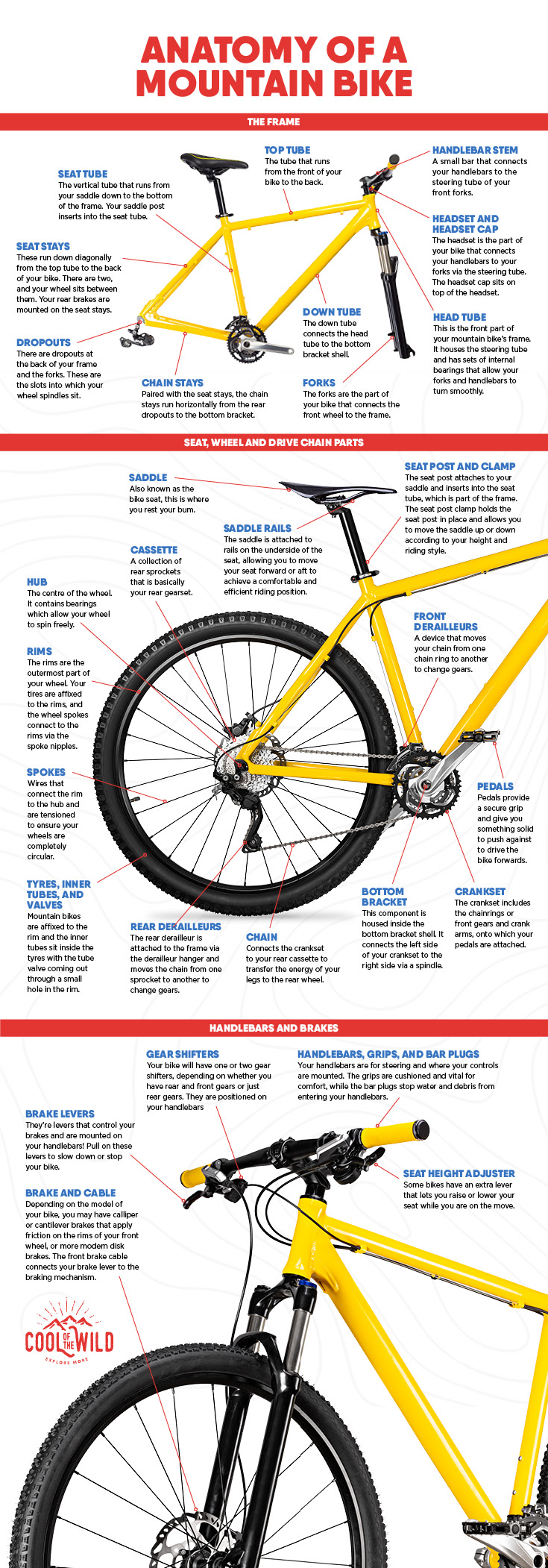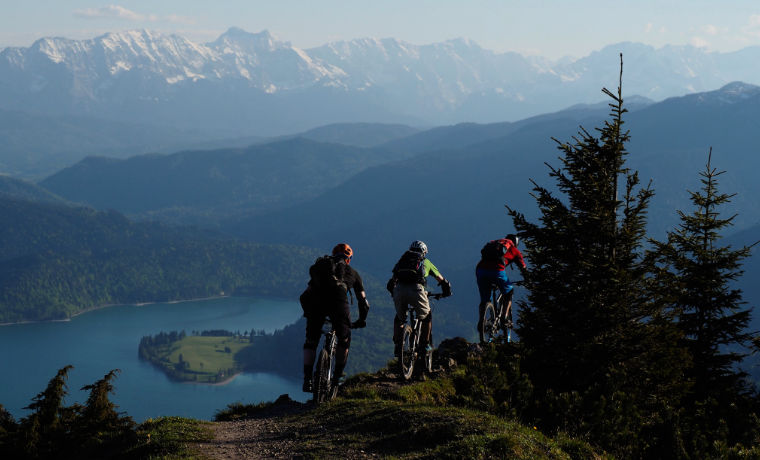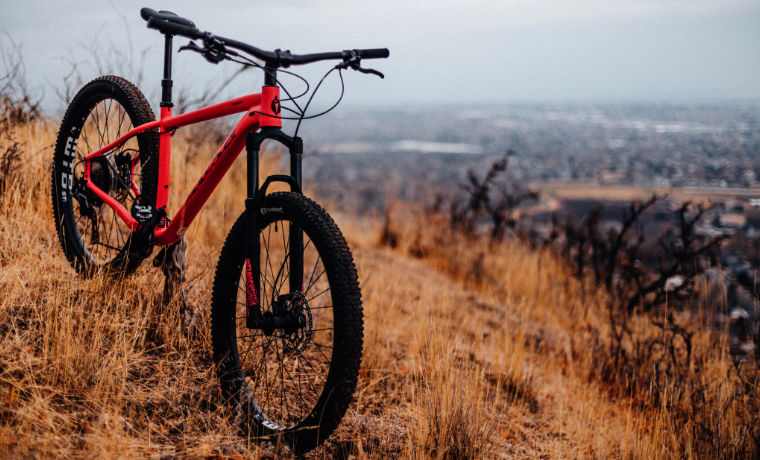Learning to ride a bike is an essential first step to becoming independent. As a kid, once you know how to ride a bike, you can travel further afield and start having adventures – either alone or with your mates.
As kids become adults, bikes usually become more sophisticated and, of course, more expensive. And sadly, bikes sometimes break down, and parts need to be replaced.
That’s especially true when you are a hard-charging mountain biker!
Because of this, it’s helpful to be able to identify the main mountain bike parts. That way, you can save yourself from having to call the components of your bike “whatsits,” “thingies,” “wingdings,” or “swannicles.”
So, to make conversations with your friendly neighbourhood bike mechanic and your fellow cyclists easier to understand, here is a guide to the most critical parts of a mountain bike.
- Mountain bike anatomy diagram
- Parts of a mountain bike, explained
- Frame parts of a mountain bike
- Front parts of a mountain bike
- Mountain bike wheel parts
- Mountain bike drive chain parts
- Mountain bike seat parts
Mountain bike anatomy diagram
Don’t know your seat post from your spoke nipple? Don’t worry – we’re here to help. Use this bicycle anatomy diagram and the explanations below to learn the name of the different parts that make up your wonderful two-wheeled friend!

What are the parts of a mountain bike?
The basic parts of a mountain bike include:
Frame parts of a mountain bike
- Top tube
- Seat tube
- Down tube
- Head tube
- Seat stays
- Chain stays
- Forks
- Dropouts
Front parts of a mountain bike
- Handlebars
- Stem
- Gear shifters
- Seat height adjuster
- Brake levers
- Headset
- Brake
Mountain bike wheel parts
- Hub
- Rims
- Spokes
- Tyres, tubes and valves
Mountain bike drive chain parts
- Cassette
- Crankset
- Derailleurs
- Bottom bracket
- Pedals
- Chain
Mountain bike seat parts
- Saddle
- Saddle rails
- Seat post and clamp
Parts of a mountain bike, explained
So now you know the basic parts of a mountain bike and how to visually locate them on your bike, let’s delve a little deeper into their purpose and how to identify them.
For ease, we’ll brake the parts of a mountain bike down into five parts:
- Frame parts of a mountain bike
- Front parts of a mountain bike
- Mountain bike wheel parts
- Mountain bike drive chain parts
- Mountain bike seat parts
01Frame parts of a mountain bike
The frame is the centre of your bike and holds all the other components together. It also tends to be the heaviest part of a bike and is usually the most expensive. It’s a good job that bike frames are very strong and seldom break.
Top tube
This is the tube that runs from the front of your bike to the back. Bikes made for women sometimes have sloping top tubes, but this is becoming increasingly rare, especially on top-quality mountain bikes.
Seat tube
The seat tube is the vertical tube that runs from your saddle down to the bottom of the frame. The angle of the seat tube affects how your bike handles, as well as your basic riding position. Your saddle post inserts into the seat tube to give you somewhere comfortable(ish!) to sit.
Down tube
The down tube connects the head tube to the bottom bracket shell. Most down tubes have built-in attachment points for water bottle cages and other accessories.
Head tube
This is the front part of your mountain bike’s frame. It houses the steering tube and has sets of internal bearings that allow your forks and handlebars to turn smoothly.
Seat stays
The seat stays run down diagonally from the top tube to the back of your bike. There are two, and your wheel sits between them. Your rear brakes are mounted on the seat stays, and some have mounting points for mudguards and panniers.
Chain stays
Paired with the seat stays, the chain stays run horizontally from the rear dropouts to the bottom bracket. With the seat stays and seat tube, they form a triangle at the back of your bike.
Forks
The forks are the part of your bike that connects the front wheel to the frame. Mountain bikes often have suspension forks, but some riders prefer rigid forks. It all depends on the type of riding and terrain you ride on.
Dropouts
– there are dropouts at the back of your frame and the forks. These are the slots into which your wheel spindles sit.

02Front parts of a mountain bike
The front parts of your bike mainly control speed and direction. These components are usually set up in a uniform manner, so the brakes on one bike are on the same side as another.
Handlebars, grips, and bar plugs
If you want to steer, brake, or change gear, your bike had better have handlebars! As well as providing you with something to hold on to, your handlebars are also where your controls are mounted. The grips are cushioned and vital for comfort, while the bar plugs stop water and debris from entering your handlebars.
Handlebar stem
The stem connects your handlebars to the steering tube of your front forks. Tall riders often prefer a long stem, while a shorter stem may be better for riders who prefer a more upright position.
Gear shifters
Your bike will have one or two gear shifters, depending on whether you have rear and front gears or just rear gears. In the “old days”, you had to select your gears by feel and listening to the chain running smoothly on the sprockets. Nowadays, most mountain bikes have indexed shifters for easier gear changes.
Seat height adjuster
Some bikes have an extra lever that lets you raise or lower your seat while you are on the move. This can be useful when transitioning from rough off-roading to a smother trial.
Brake levers
They’re levers that control your brakes! Pull on these levers to slow down or stop your bike. Most brake levers are short and can be operated with just two fingers, so you can maintain a decent grip on your handlebars.
Headset and headset cap
The headset is the part of your bike that connects your handlebars to your forks via the steering tube. The headset cap sits on top of the headset and can be adjusted to exert more or less pressure on the headset, which affects steering and front fork/handlebar play.
Front brake and cable
Depending on the model of your bike, you may have calliper or cantilever brakes that apply friction on the rims of your front wheel, or more modern disk brakes. Disk brakes are more powerful but also tend to cost more. The front brake cable connects your brake lever to the braking mechanism.
03Mountain bike wheel parts
The wheel is arguably one of the most important inventions in human history. The quality of your wheels can have a significant impact on how your bike performs, which is why they’re often the first thing riders upgrade.
Hub
This is the centre of the wheel. It contains bearings which allow your wheel to spin freely. Most hubs have a quick-release mechanism so you can remove your wheels without tools, which is handy when you need to carry out roadside repairs. The centre of the hub is called the spindle.
Rims
The rims are the outmost part of your wheel. Your tires are affixed to the rims, and the wheel spokes connect to the rims via the spoke nipples. Wide rims tend to be stronger but heavier than narrow rims, whilst thinner rims are usually faster and more aerodynamic.
Spokes
The spokes are wires that connect the rim to the hub and are tensioned to ensure your wheels are completely circular. Tightening or loosening the spokes will change the shape of the wheel, and you can use a device called a spoke key to “true” your wheels, so they rotate smoothly and without wobbling or rubbing on your brakes.
Tires, inner tubes, and valves
Mountain bikes tend to have chunky tires for better grip. That said, smooth tires provide less rolling resistance and are better if you plan on doing miles on the road.
The inner tubes hold the air that gives your tires their shape and firmness. Some bikes have tubeless tires, but this is more common on road bikes.
The valves allow you to connect your inner tubes to a pump for inflation to the correct tire pressure. Valves come with dust caps, which help keep debris out of the valve.

04Mountain bike drive chain parts
Unless you plan on freewheeling everywhere, the drive chain is probably the most essential part of a mountain bike as it converts your muscle power to forward momentum. It’s also the most complicated part of our mountain bike diagram.
Cassette
This is a collection of rear sprockets and is basically your rear gearset. Depending on your bike, you may have anywhere from five to 11 sprockets or gears. Cassettes are often interchangeable, so you can change your gear ratios according to the terrain you’ll be riding.
Crankset
The crankset includes the chainring(s)s or front gears and crank arms, onto which your pedals are attached. Depending on your bike, you may have one, two, or three chainrings. More chain rings mean more gears.
Derailleurs
The derailleur is a device that moves your chain from one sprocket to another to change gears. Most mountain bikes have rear and front derailleurs, but some only have one on the rear.
Rear derailleurs have a component called a jockey wheel, which is sprung to keep the chain under constant tension, even when it’s on the smallest diameter gear sprocket. The rear derailleur is attached to the frame via the derailleur hanger.
Bottom bracket
This component is housed inside the bottom bracket shell. It connects the left side of your crankset to the right side via a spindle. Bottom brackets contain sets of bearings to ensure they turn smoothly.
Pedals
This is where your body finally meets your bike! Pedals provide a secure grip and give you something solid to push against. There are many different types of pedal designs to choose from, including basic “bear traps” and clipless pedals that only work with compatible cycling shoes.
Chain
The chain connects the crankset to your rear cassette to transfer the energy of your legs to the rear wheel. The links in the chain match the teeth on the sprockets to ensure that it doesn’t slip and that no energy is wasted. Despite being made of metal, bike chains stretch over time and may need to be adjusted.
05Mountain bike seat parts
While you’ll probably spend a fair bit of your time standing on your pedals, you’ll probably need to sit down at least some of the time. These are the parts that make up the seat of your mountain bike.
Saddle
Also known as the bike seat, this is where you rest your bum. Bike saddles come in a variety of shapes and sizes. Some are wide and padded, while others are narrow and thin. Needless to say, you need a comfortable saddle if you plan on spending a lot of time on your bike.
Saddle rails
The saddle is attached to rails, allowing you to move your seat forward or aft to achieve a comfortable and efficient riding position. Some also allow you to tip the nose of your saddle up or down.
Seat post and clamp
The seat post attaches to your saddle and inserts into the seat tube, which is part of the frame. The seat post clamp holds the seat post in place and allows you to move the saddle up or down according to your height and riding style. Most seat clamps have a quick-release mechanism, so you can make adjustments without tools.
Mountain bike parts – closing thoughts
You should now know the name of all the main parts of a mountain bike. You should also have a reasonable idea of what most of those parts do.
The next thing to find out is how to maintain the bike parts labelled on our diagram so your mountain bike is always ready for adventure, but that’s a whole different article!
The post Parts of A Mountain Bike, Explained (With Useful Diagram) appeared first on Cool of the Wild.


